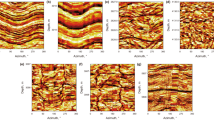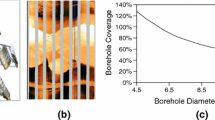Abstract
Images created from measurements made by wireline microresistivity imaging tools have longitudinal gaps when the well circumference exceeds the total width of the pad-mounted electrode arrays. The gap size depends on the tool design and borehole size, and the null data in these gaps negatively affect the quantitative evaluation of reservoirs. Images with linear and texture features obtained from microresistivity image logs have distinct dual fabric features because of logging principles and various geological phenomena. Linear image features usually include phenomena such as fractures, bedding, and unconformities. Contrarily, texture-based image features usually indicate phenomena such as vugs and rock matrices. According to the characteristics of this fabric-based binary image structure and guided by the practice of geological interpretation, an adaptive inpainting method for the blank gaps in microresistivity image logs is proposed. For images with linear features, a sinusoidal tracking inpainting algorithm based on an evaluation of the validity and continuity of pixel sets is used. Contrarily, the most similar target transplantation algorithm is applied to texture-based images. The results obtained for measured electrical imaging data showed that the full borehole image obtained by the proposed method, whether it was a linear structural image reflecting fracture and bedding or texture-based image reflecting the matrix and pore of rock, had substantially good inpainting quality with enhanced visual connectivity. The proposed method was effective for inpainting electrical image logs with large gaps and high angle fractures with high heterogeneity. Moreover, ladder and block artifacts were rare, and the inpainting marks were not obvious. In addition, detailed full borehole images obtained by the proposed method will provide an essential basis for interpreting geological phenomena and reservoir parameters.
Similar content being viewed by others
References
Du, J. H., 2010, Petroleum exploration of carboniferous volcanic rocks in Northern Xinjiang: Petroleum industry press, 3–21.
Zhang, C. E., Pan, B. Z., Zhang, X. F., et al., 2011, Application of FMI logging data in evaluation of heterogeneity reservoirs: Geophysical Prospecting for petroleum, 50(5), 630–633.
Zuo, C. J., Wang, Z. W., Xiang, M., et al., 2016, The radial pore heterogeneity of volcanic reservoir based on the porosity analysis of micro-electric imaging logging: Geophysical Prospecting for petroleum, 55(3), 449–454.
Liu, R. L., Xie, F., Xiao, C. W., et al., 2017, Extracting fracture-vug plane porosity from electrical imaging logging data using dissection of wavelet-transform-based image: Chinese Journal Geophysics, (in Chinese), 60(2), 4945–4955.
Aubert, G., and Kornprobst, P., 2006, Mathematical problems in image processing: partial differential equations and the calculus of variations: Springer science business media.
Shao, X. W., 2006, Research on digital image restoration technology: University of Science and Technology of China, Hefei.
Alilou, V. K., and Yanghmaee, F., 2016, Exemplar-based image inpainting using SVD-based approximation matrix and multi-scale analysis: Multimedia tools and application, 75(1), 1–22.
Bertalmio, M., Sapiro, G., Caselles, V., et al., 2000, Image inpainting: Proceedings of SIGGRAPH, New Orleans, 417–424.
Li, L., Guo, S. X., and Chen, G. F., 2012, Based on partial differential equations of image inpainting: Journal of Jilin University (information Science Edition), 30(1), 72–77.
Chan, T. F., and Shen, J., 2002, Mathematical models for local non-texture inpaintings: SIAM journal on Applied Mathematics, 62: 1019–1043.
Shao, X. W., Liu, Z. K., and Song, B., 2004, An adaptive image inpainting approach based on TV model: Journal of Circuits and Systems, 9(2), 113–117.
Ge, S. M., Cheng, Y. M., Zeng, D., et al., 2008, Image inpainting by combing gray levels and gradient directions: Journal of Circuits and Systems, 13(4), 33–38.
Criminisi, A., Perez, P., and Toyama, K., 2004, Region filling and object removal by exemplar-based image inpainting: IEEE Transactions on Image Processing, 13(9), 1200–1212.
Sarawut, T., and Akinori, N., 2011, Iterative gradient-driven patch-based inpainting: Y.-S.Ho(Ed.), PSIVT 2011, part II, LNCS 7088, 71–81.
Wu, X., Zeng, W., and Li, Z., 2011, Exemplar-based image inpainting with collaborative filtering: In 6th international conference on image and graphics, Hefei, Anhui, China, 8–11.
Sarawut, T., and Akinori, N., 2011, Exemplar-based image inpainting with patch shifting scheme: In 17th international conference on digital signal processing, 1–5.
Wang, M. Q., 2011, A Novel Image Inpainting Method based on Image Decomposition: Procardia Engineering, 15, 3733–3738.
Jemi Florinabel, D., Ebenezer Juliet, S., and Sadasivam, V., 2011, Combined frequency and spatial domain-based patch propagation for image completion: Computers & Graphics, 35, 1051–1062.
Sangeetha, K., Sengottuvelan, P., and Balamurugan, E., Combined structure and texture image inpainting algorithm for natural scene image completion: Journal of information engineering and applications, 1(1), 7–12.
Wong, A., and Orchard, J., 2008, A nonlocal-means approach to exemplar-based inpainting: Proc of the 15th IEEE international conference on image processing, 2600–2603.
Huang, S. B., Zhu, X. L., Xu, Y. Y., et al., 2011, An improved image inpainting galogrithm based on texture synthesis: Journal of Hefei University of Technology, 34(2), 313–316.
Arias, P., Caselles, V., and Facciolo, G., 2012, Analysis of a variational framework for exemplar-based image inpainting: Multiscale modeling and simulation, 10(2), 473–514.
Kang, X. Q., 2005, A method of whole wellbore restoration for electrical imaging logging: China Invention Patent, 200510075171.
Hueley, N. F., and Zhang, T. F., 2011, Method to generate full-bore images using borehole images and multi-point statistics: SPE Reservoir Evaluation MYM Engineering, 14(2), 204–214.
Zhang, T. F., 2008, Incorporating geological conceptual models and interpretations into reservoir modeling using multiple point geostatistics: Earth science frontiers, 15(1), 26–35.
Sun, J. M., Zhao, J. P., Lai, F. Q., et al., 2011, Methods to fill in the gaps between pads of electrical logging images: Well Logging Technology, 35(6), 532–537.
Assous, S., Elkington, P., and Whetton, J., 2014, Microresistivity borehole image inpainting: Geophysics, 79(2), D31–D39.
Xing, Q., and Zhang, J. Y., 2017, Filling in gaps between pads of electrical logging images with MVA method: Well Logging Technology, 41(5), 555–559.
Zhou, C. C., Li, C. L., Wang, C. X., et al., 2013, Logging petrophysics and processing evaluation of complex clastic rock: Petroleum industry press, 155–193.
Li, N., Wang, C. Z., Liu, Y. M., et al., 2013, CIFLog, the 3rd generation logging software based on the Java-NetBeans: Acta Petrolei Sinica, 34(1), 192–200.
Zhang, X., Zhang, M., Xiao, X. L., et al., 2018, Image inpainting for fullbore electrical imaging logging in complex formations: Geophysical Prospecting for petroleum, 57(1), 148–153.
Wang, Q., 2002, The method research of well logging interpretation on fractured reservoir: China University of Geosciences (Wu Han).
Zhang, Y., and Pan, B. Z., 2012, On three calculation methods of volcanic reservoir fracture porosity based on FMI data: Well Logging Technology, 36(4), 365–369.
Gong, C., and Wang, Z. L., 2016, Proficient in MATLAB optimization calculation (4th Edition): Electronic Industry Press, 34–65.
Yang, X. H., 2013, Research on digital image inpainting technologies based on structure tensor: University of Electronic Science and Technology of China, Chengdu.
Liu, L. P., and Li, H., 2009, Image completion based on weighting patch match: 5th international conference on image and graphics, IEEE, 824–829.
Zhai, D. H., Xiao, J., Yu, J., et al., 2013, Image inpainting algorithm based on adaptive template: Journal of Computer Application, 33(10), 2891–2894.
Zhao, Q., He, J. H., and Wen, P., 2012, Image fusion method based on average grads and wavelet contrast: Computer Engineering and Application, 48(24), 165–168.
Acknowledgments
The authors are grateful to Researcher Huo Shoudong, Professor Liu Hua-qing, and Li Xiang-bo for their suggestions. Thanks to the comments and suggestions of the reviewers and the extensive help provided by the editorial staff .
Author information
Authors and Affiliations
Corresponding author
Additional information
This work was supported by Initial Scientific Research Fund for Doctor of Xinjiang University (No. 620321016), Gansu Provincial Natural Science Foundation of China (No. 17JR5RA313), Key Laboratory of Petroleum Resource Research of Chinese Academy of Science Foundation (No. KFJJ2016-02).
Zhang Zhao-hui, assistant professor, graduated from Yangtze University with a bachelor’s degree in 2005, graduated from Yangtze University with a master’s degree in 2008, received a Ph.D. in Mineralogy, Petrology & Mineral Deposits from the University of Chinese Academy of Sciences in 2020. He is currently working at School of Geology and Mining Engineering Xinjiang University, Urumqi, China. His research interests include well logging processing and interpretation methods for unconventional reservoirs.
Rights and permissions
About this article
Cite this article
Zhang, Zh., Deng, J., Chen, Hy. et al. Self-adaptively inpainting gaps between electrical image pads according to the image fabric. Appl. Geophys. 17, 823–833 (2020). https://doi.org/10.1007/s11770-020-0878-7
Received:
Revised:
Published:
Issue Date:
DOI: https://doi.org/10.1007/s11770-020-0878-7




